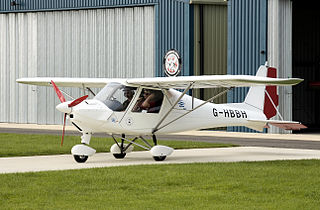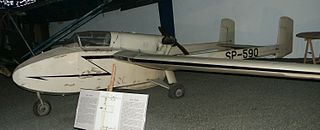
A fixed-wing aircraft is a heavier-than-air flying machine, such as an airplane, which is capable of flight using wings that generate lift caused by the aircraft's forward airspeed and the shape of the wings. Fixed-wing aircraft are distinct from rotary-wing aircraft, and ornithopters. The wings of a fixed-wing aircraft are not necessarily rigid; kites, hang gliders, variable-sweep wing aircraft and airplanes that use wing morphing are all examples of fixed-wing aircraft.
The A-2 Vautour (Vulture) was a single-seat French glider that was designed by Georges Abrial. It performed well at the Vauville competition of 1925.

In engineering, a longeron or stringer is a load-bearing component of a framework.

A forward-swept wing or reverse-swept wing is an aircraft wing configuration in which the quarter-chord line of the wing has a forward sweep. Typically, the leading edge also sweeps forward.

The General Aircraft GAL.56 was a family of 1940s British experimental tailless swept wing glider designs.

The Ikarus C42 is a two-seat, fixed tricycle gear, general aviation microlight aircraft, manufactured in Germany by Comco Ikarus. It is used primarily for flight training, touring and personal flying.

Washout is a characteristic of aircraft wing design which deliberately reduces the lift distribution across the span of an aircraft’s wing. The wing is designed so that the angle of incidence is greater at the wing roots and decreases across the span, becoming lowest at the wing tip. This is usually to ensure that at stall speed the wing root stalls before the wing tips, providing the aircraft with continued aileron control and some resistance to spinning. Washout may also be used to modify the spanwise lift distribution to reduce lift-induced drag.

HWL Pegaz was the first Polish post-war motor glider, a single-seat mid-wing monoplane with a pusher propeller and twin tail boom, which was designed and constructed by Tadeusz Chyliński and was built in Warsaw-Goclaw Aircraft Plant 6.

The SZD-24 Foka (Seal) was a single-seat high-performance aerobatic glider designed and built in Poland in 1960.

The Boulton & Paul P.10 was a two-seat, single-engined biplane built just after World War I to develop techniques for the construction of all steel aircraft. It is also notable for its first use of plastic as a structural material. Only one P.10 was built and it attracted much attention; but it probably never flew.

The Slingsby Type 51 Dart is a single seat competition glider designed in the early 1960s, initially as a 15 m span Standard Class aircraft but evolved into an Open Class, 17 m sailplane. It was the last Slingsby sailplane to be mostly constructed of wood.

A glider or sailplane is a type of glider aircraft used in the leisure activity and sport of gliding. This unpowered aircraft can use naturally occurring currents of rising air in the atmosphere to gain altitude. Sailplanes are aerodynamically streamlined and so can fly a significant distance forward for a small decrease in altitude.

The Supermarine Spitfire is a British single-seat fighter aircraft used by the Royal Air Force and other Allied countries before, during, and after World War II. Many variants of the Spitfire were built, from the Mk 1 to the Rolls-Royce Griffon-engined Mk 24 using several wing configurations and guns. It was the only British fighter produced continuously throughout the war. The Spitfire remains popular among enthusiasts; around 70 remain airworthy, and many more are static exhibits in aviation museums throughout the world.

The Hannover H.1 Vampyr was a German glider designed by Georg Madelung for the 1921 Rhön gliding competition, which was held at the Wasserkuppe from 8 August to 25 August 1921. The Vampyr is believed to be the first heavier than air aircraft to use stressed skin. Several historical societies have argued that the aircraft is the precursor of all modern sailplanes.

The Maupin Carbon Dragon is an American, high-wing, single-seat, glider that was designed by Jim Maupin and made available as plans for amateur construction. Plans are no longer available.
The Akaflieg Darmstadt D-34 sailplanes were a series of experimental single seat sailplanes, designed at the University of Darmstadt in the 1950s and early 1960s to explore the structural and aerodynamic advantages of the then emerging plastics and composite materials.
The Graham-White Type VII "Popular" was an early British aircraft designed by J. D. North and built by the Grahame-White Aviation company, with the intention of producing a low-cost aircraft to popularize aviation. It was initially produced with a 35 hp Anzani 3-cylinder Y configuration engine and offered for sale at a price of less than £400. Despite its low price the aircraft included structural refinements such as hollow-section interplane struts. It was first flown in 1913.

The Martinsyde Semiquaver was a British single-seat racing biplane built by Martinsyde in 1920. It won the 1920 Aerial Derby and was entered for the 1920 Gordon Bennett Trophy, but did not finish the course. In 1921 the fuselage was used as the basis for the Alula Monoplane, an experimental aircraft intended to investigate the performance of a radical wing design by A. A Holle.

The Bonomi BS.7 Allievo Italia was a single seat, primary glider designed and built in Italy in the 1920s.

The Rotter Karakán or just the Karakán was a high performance Hungarian single seat sailplane. Two were built and set many national gliding records in the years before World War II.


















